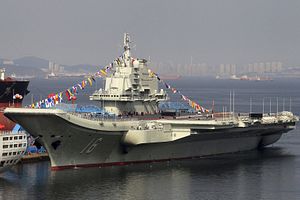As several Diplomat articles have noted, China has launched its first domestically constructed aircraft carrier. The ship, built to a design similar to that of Liaoning, is the largest military vessel ever constructed in China, and represents a major national achievement. The new carrier (provisionally named Shandong) will enter service in 2020, some eight years after her half-sister Liaoning, and 30 years after her other half-sister, Admiral Kuznetsov, the lead carrier in the Soviet vessel class Liaoning originally belonged to.
Although separated by the gulf of nearly a century, it’s worth considering the progress of the Chinese program against that of the Japanese carrier aviation program in the 20th century. Both the PLAN and the Imperial Japanese Navy (IJN) started from nearly scratch, and the progress of the former has closely tracked that of the latter.
In December 1922 the IJN commissioned Hosho, the world’s first purpose-built aircraft carrier. Hosho displaced about 9,000 tons, very small even for an interwar carrier. She could carry about 15 aircraft, depending on configuration, and steam at roughly 25 knots. She was smaller than contemporary British carriers, but the keel-up construction gave her an advantage over larger conversions.
The PLAN has undertaken its naval aviation program with minimal foreign assistance. It acquired the hulk that became Liaoning from Ukraine, and the Su-27 from Russia, but has otherwise had to manage the complications of a new carrier program on its own. The Japanese, on the other hand, had some help. The IJN had maintained connections with the Royal Navy since the second half of the 19th century, and at one point ordered most of its heavy ships from British yards. Thus, when the IJN jumped into carrier aviation, it had assistance from the only country in the world that had experience with aircraft carriers. The British had been flying from carriers since 1918, and British pilots were among the first to land on HIJMS Hosho. These pilots helped train the first contingent of Japanese pilots.
Hosho would serve as Japan’s only carrier for five years, before the completion of HIJMS Akagi in 1927, a timeline roughly similar to that of the PLAN. Most of Hosho’s duties involved training, and the development of tactics and techniques for handling aircraft that would become central to the progress of Japanese naval aviation. Many analysts expect Liaoning to perform these kinds of duties for the foreseeable future. Two additional carriers would enter service in the early 1930s, although all of the ships (except Hosho) underwent significant refits. In January 1932, alongside those of HIJMS Kaga, Hosho’s aircraft would conduct the IJN’s first carrier combat operations, against Chinese positions during the Shanghai Incident.
Despite participating in some combat operations at the beginning of World War II, Hosho continued to serve mainly in her traditional role as a training vessel. Surprisingly, she survived the war, despite taking serious damage in several air attacks in 1945. Pressed back into service to return Japanese military personnel after the war, she was scrapped in 1946.
At the moment China seems to be taking the same kind of careful approach to its carrier program as Japan took during the interwar period. Liaoning has already enjoyed a remarkable career; it remains to be seen whether she will, in the aftermath of the commissioning of her more modern half-sister, continue to conduct primarily training duties, or whether she will be placed in an operational role.

































